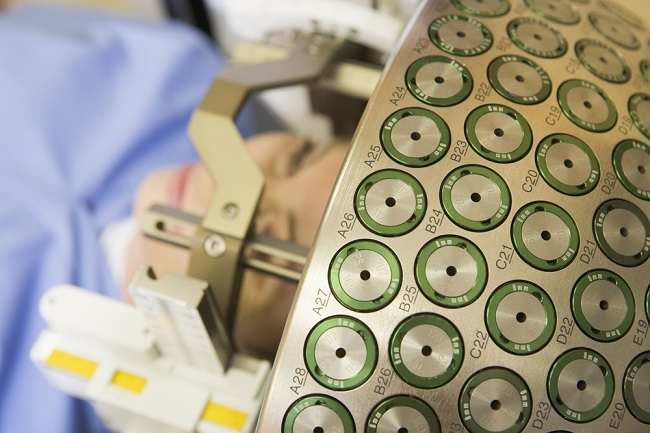Brachytherapy or internal radiotherapy is a procedure to treat cancer by introducing radiation directly into the body. Brachytherapy is often used to treat tumors in the head, neck, eyes, breast, cervix, and prostate.
Brachytherapy is done by inserting implants containing radiation into the body, directly inside the tumor or in the area around the tumor. The radiation serves to kill cancer cells and shrink the size of the tumor.

Compared to radiotherapy given from outside the body (external radiotherapy), this type of radiotherapy can deliver higher doses of radiation and are more targeted to cancer tissue.
Brachytherapy is considered more beneficial than external radiotherapy, because healthy tissue around the tumor can be protected from radiation exposure. However, the drawback of brachytherapy is that it cannot be used to treat cancer that has spread (metastasized).
Indications and contraindications for brachytherapy
Brachytherapy can be used to treat various types of cancer, such as:
- prostate cancer
- Breast cancer
- Endometrial cancer
- Esophageal cancer
- bile duct cancer
- Cervical cancer
- Endometrial cancer
- eye cancer
- Head and neck cancer
- Brain cancer
- Lung cancer
- Pancreatic cancer
- Colorectal cancer
- Skin cancer
- Vaginal cancer
- Soft tissue cancer
However, brachytherapy cannot be performed or should be postponed if the patient has the following conditions:
- Cancer has spread to the lymph nodes
- Cancer has spread to other body tissues
- Having morbid obesity
- Chances of recovery are low
- Is pregnant
- Have another type of cancer, apart from the cancer to be treated
- Have had brachytherapy before in the same section
Brachytherapy Warning
Brachytherapy is an effective treatment method for treating several types of cancer. Even so, patients are advised to continue to discuss with their doctor about the benefits and risks of this procedure.
Keep in mind, brachytherapy does not guarantee complete recovery. To increase the potential for cure, this procedure may need to be combined with other treatment methods, such as tumor surgery or external radiotherapy.
During brachytherapy, the patient's body may contain radiation that can cause side effects on other people in close proximity. Therefore, patients will be advised to limit interactions with other people, especially children and pregnant women.
Before Brachytherapy
Patients need to first conduct an examination and consultation with an oncologist to plan brachytherapy. The reason is, the amount of radiation given and the arrangement of implants will be determined based on the health condition of each patient, the type of cancer experienced, and the location of the cancer.
The doctor will ask questions regarding the patient's medical history, perform a thorough physical examination, and perform laboratory tests, such as a complete blood count, organ function tests, or urine tests. Patients may also be asked to undergo imaging tests, such as X-rays, CT scans, or MRIs.
If the patient is taking drugs that can affect the blood clotting process, such as warfarin, or non-steroidal anti-inflammatory drugs (NSAIDs), the doctor will ask the patient to stop taking the drug for some time before starting brachytherapy.
The patient will also be asked to fast for a few hours before brachytherapy. In some cases, the doctor will give the patient a special fluid to clean the intestines.
Brachytherapy Procedure
Brachytherapy is performed in a special operating room that can keep radiation indoors. Brachytherapy procedures performed may vary, depending on the technique used and the type of cancer being treated.
For example, to treat prostate cancer, brachytherapy is done by inserting radiation implants directly into the tumor. Meanwhile, to treat cervical cancer or endometrial cancer, brachytherapy is done by placing radiation implants in body cavities or cavities created through surgery.
Before starting the procedure, doctors and nurses will wear special equipment that can protect the body from radiation exposure. Once the doctor is ready, the patient will then be asked to lie down on the operating bed.
Next, the doctor will put an IV tube in the patient's arm or hand to introduce drugs into the body, including anesthetics. Depending on the type of tumor being treated, the anesthesia may be general or local.
When the anesthetic has worked, the doctor will use a plastic or metal applicator to insert the radiation implant into the specified area. In this process, doctors can also use the help of scanners, such as X-rays, MRI, or CT scans, to find the right position to place the implant.
The implants inserted can be seeds, ribbons, cables, capsules, tubes, balloons, or needles, and there can be one or more of them. The radiation material used can be iodine, palladium, cesium, or iridium.
The next step of brachytherapy varies, according to the type of implant used. Here's the explanation:
Low dose implant brachytherapy
Implants with low radiation doses will be placed in the body for 1–7 days. As long as the implant is in the body, the patient will need to stay in the hospital. During this time, the applicator will be left in the body.
Patients will be placed in special treatment rooms and must comply with a number of regulations, which include:
- Stay in the treatment room that has been prepared.
- Remain in bed and limit body movement to prevent the implant from shifting, especially if the implant is large enough.
- Follow the rules of the visit, usually only allowed for 30 minutes.
- Limit and use portable shields when interacting with other people.
- Not to be visited by pregnant women and children.
The patient will not experience pain during the radiation work. However, the patient can tell the nurse or doctor if they feel uncomfortable because of the applicator.
After the radiation has worn off, the doctor will remove the implant and applicator from inside the body. Anesthesia may be given again prior to the removal of the implant and applicator to prevent pain.
High dose implant brachytherapy
In this brachytherapy, implants will be inserted into the body using the help of a computer machine. Once inserted, the implant will remain in the body for 10–20 minutes. This process is generally painless.
During the process, the patient will be in the operating room alone. The doctor will be in another room, but will still be able to see and hear the patient. Patients can also communicate with doctors via microphone.
Depending on the type of cancer being treated, high-dose implants may be inserted twice a day for 2–5 days or once a week for 2–5 weeks. During this period, the applicator can remain in place or can be removed and reinserted at each brachytherapy session.
This brachytherapy procedure can be done on an inpatient or outpatient basis. However, if the implant needs to be inserted more than once a day, the patient usually has to stay in the hospital.
After the brachytherapy is completed, the implant and applicator will be removed from the body. If needed, an anesthetic may also be given again to prevent pain from developing during this process.
Permanent implant brachytherapy
Permanent implants are implants that will be left in the patient's body for life. These implants work by continuously releasing radiation little by little. The radiation dose will decrease every day until it finally wears off by itself. Generally, radiation lasts for several weeks or months.
Similar to other brachytherapy, the installation of permanent implants is also carried out in a special room. However, the applicator will be removed immediately after installation. Due to their very small size, these implants will not cause pain or discomfort even if they are left in the body.
After Brachytherapy
Once the low-dose or high-dose implant has been removed and the anesthetic has worn off, the patient will usually be discharged immediately.
Patients need not be afraid to interact with other people after undergoing brachytherapy with high or low dose implants, because the patient's body will not contain radiation that can harm others after the implant is removed from the body.
Meanwhile, in patients undergoing permanent implants, patients may need to stay in the hospital for several days until the radiation levels are weak enough. This is to ensure that radiation from inside the patient's body does not harm those around him.
Even though they are allowed to go home, patients undergoing permanent implants should remain vigilant by limiting interactions with pregnant women and children while at home.
Also, the area where the applicator is inserted may be painful and uncomfortable for several months. The doctor will give painkillers to relieve this complaint.
If needed, the doctor will also suggest a scan test after brachytherapy to check if the brachytherapy is working properly. The type of scan performed will depend on the type and location of the cancer.
Brachytherapy Side Effects
Each type of brachytherapy can cause side effects. The following are some of the side effects that patients can experience as a result of brachytherapy:
- Fatigue
- Hair loss
- Headache
- Ulcer
- Nausea and vomiting
- Hard to breathe
- Cough
- Difficulty holding in urine (urinary incontinence)
- Difficulty holding bowel movements
- Constipation
- Diarrhea
- Erectile dysfunction
Generally, the above side effects will improve as radiation levels decrease. Immediately consult a doctor if there are more serious side effects, such as:
- Difficulty breathing or swallowing
- Severe stomach pain, vomiting, or diarrhea









